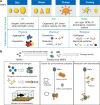Nanoparticles: Weighing the Pros and Cons from an Eco-genotoxicological Perspective
- PMID: 34258247
- PMCID: PMC8249203
- DOI: 10.15430/JCP.2021.26.2.83
Nanoparticles: Weighing the Pros and Cons from an Eco-genotoxicological Perspective
Abstract
The exponential growth of nanotechnology and the industrial production have raised concerns over its impact on human and environmental health and safety (EHS). Although there has been substantial progress in the assessment of pristine nanoparticle toxicities, their EHS impacts require greater clarification. In this review, we discuss studies that have assessed nanoparticle eco-genotoxicity in different test systems and their fate in the environment as well as the considerable confounding factors that may complicate the results. We highlight key mechanisms of nanoparticle-mediated genotoxicity. Then we discuss the reliability of endpoint assays, such as the comet assay, the most favored assessment technique because of its versatility to measure low levels of DNA strand breakage, and the micronucleus assay, which is complementary to the former because of its greater ability to detect chromosomal DNA fragmentation. We also address the current recommendations on experimental design, including environmentally relevant concentrations and suitable exposure duration to avoid false-positive or -negative results. The genotoxicity of nanoparticles depends on their physicochemical features and the presence of co-pollutants. Thus, the effect of environmental processes (e.g., aggregation and agglomeration, adsorption, and transformation of nanoparticles) would account for when determining the actual genotoxicity relevant to environmental systems, and assay procedures must be standardized. Indeed, the engineered nanoparticles offer potential applications in different fields including biomedicine, environment, agriculture, and industry. Toxicological pathways and the potential risk factors related to genotoxic responses in biological organisms and environments need to be clarified before appropriate and sustainable applications of nanoparticles can be established.
Keywords: DNA damage; Genotoxicology; Nanoparticles; Nanotoxicology; Risk assessment.
Copyright © 2021 Korean Society of Cancer Prevention.
Conflict of interest statement
CONFLICTS OF INTEREST No potential conflicts of interest were disclosed.
Figures



Similar articles
-
Genotoxicity of metal based engineered nanoparticles in aquatic organisms: A review.Mutat Res Rev Mutat Res. 2017 Jul;773:134-160. doi: 10.1016/j.mrrev.2017.05.004. Epub 2017 Jun 4. Mutat Res Rev Mutat Res. 2017. PMID: 28927524 Review.
-
Can the comet assay be used reliably to detect nanoparticle-induced genotoxicity?Environ Mol Mutagen. 2015 Mar;56(2):82-96. doi: 10.1002/em.21933. Epub 2014 Dec 8. Environ Mol Mutagen. 2015. PMID: 25488706 Review.
-
The comet assay with multiple mouse organs: comparison of comet assay results and carcinogenicity with 208 chemicals selected from the IARC monographs and U.S. NTP Carcinogenicity Database.Crit Rev Toxicol. 2000 Nov;30(6):629-799. doi: 10.1080/10408440008951123. Crit Rev Toxicol. 2000. PMID: 11145306 Review.
-
The Minderoo-Monaco Commission on Plastics and Human Health.Ann Glob Health. 2023 Mar 21;89(1):23. doi: 10.5334/aogh.4056. eCollection 2023. Ann Glob Health. 2023. PMID: 36969097 Free PMC article. Review.
-
How to reduce false positive results when undertaking in vitro genotoxicity testing and thus avoid unnecessary follow-up animal tests: Report of an ECVAM Workshop.Mutat Res. 2007 Mar 30;628(1):31-55. doi: 10.1016/j.mrgentox.2006.11.008. Epub 2007 Jan 13. Mutat Res. 2007. PMID: 17293159
Cited by
-
Epigenetic Regulation in Exposome-Induced Tumorigenesis: Emerging Roles of ncRNAs.Biomolecules. 2022 Mar 28;12(4):513. doi: 10.3390/biom12040513. Biomolecules. 2022. PMID: 35454102 Free PMC article. Review.
-
Alleviation of calcium hydroxide nanoparticles induced genotoxicity and gastritis by coadministration of calcium titanate and yttrium oxide nanoparticles in mice.Sci Rep. 2023 Dec 12;13(1):22011. doi: 10.1038/s41598-023-49303-x. Sci Rep. 2023. PMID: 38086889 Free PMC article.
-
A One-Step Approach for a Durable and Highly Hydrophobic Coating for Flax Fabrics for Self-Cleaning Application.Molecules. 2024 Feb 13;29(4):829. doi: 10.3390/molecules29040829. Molecules. 2024. PMID: 38398582 Free PMC article.
References
-
- Future Markets, author. [Accessed January 15, 2021];Nanomaterials, the global market, forecast from 2010 to 2025. https://www.futuremarketsinc.com/the-global-market-for-nanomaterials-20...
-
- Sun TY, Mitrano DM, Bornhöft NA, Scheringer M, Hungerbühler K, Nowack B. Envisioning nano release dynamics in a changing world: using dynamic probabilistic modeling to assess future environmental emissions of engineered nanomaterials. Environ Sci Technol. 2017;51:2854–63. doi: 10.1021/acs.est.6b05702. - DOI - PubMed
Publication types
LinkOut - more resources
Full Text Sources
Miscellaneous
